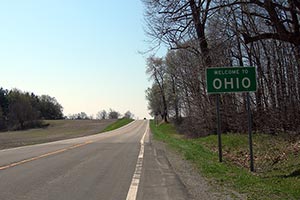Ohio Looks for More 'Smart' Road Corridors

Ohio wants to experiment with changing highway speed limits based on traffic and road conditions at different times during the day, in addition to developing “smart corridors” to test driverless vehicles.
“We’re confident that computer sensors will not fall asleep, shave, put on lipstick, text or drive drunk,” Anthony Yacobucci, chief engineer for the Ohio Turnpike and Infrastructure Commission, told a House Finance subcommittee Feb. 7.
Gov. John Kasich’s $7 billion, two-year transportation and public safety budget, sponsored by Rep. Robert McColley, is fueled largely by motor-fuel taxes, federal funds and borrowing by the state and turnpike. It is separate from the state’s broader general revenue budget and must reach the governor’s desk by April 1, so the state spending can start with the dawn of the next fiscal year July 1.
RELATED: Ohio eyes self-driving trucks, cars tests
Starting in 2018, the Ohio Department of Transportation wants to test the concept of varying speed limits and temporarily opening a road’s shoulder as an added lane during rush hour — starting with an experiment on Interstate 670 in Columbus.
“Through the years, we have shown that we cannot just build our way out of congestion,” state Transportation Director Jerry Wray told the transportation subcommittee. “… We are spending over 90% of our capital construction dollars on preserving and maintaining what we already have. Using technology, ... we can operate our system more efficiently and achieve better results. …”
I-670 is a seven-mile commuter corridor into downtown Columbus, linking the I-270 beltway on the east to I-70 to the west of downtown.
“During peak hours on many Ohio highways, excessive starting and stopping of motorists results in waves of backed-up vehicles and the potential for increased accidents,” Wray said. “It has been proven that during high periods of demand on roadways, a temporary, slower speed limit results in a smoother and more even flow of traffic.”
ODOT, however, has the authority to vary speed limits only in school and work zones. The Ohio Turnpike has such authority but has not taken full advantage of it.
Of its $7.8 billion, the budget would provide $6.5 billion for ODOT, 86% of which goes toward construction projects. The Department of Public Safety would receive nearly $1.2 billion.
Kasich had announced plans to invest in “smart” road technology, installing fiber optics and roadway sensors on a 35-mile stretch of U.S. Route 33 from Dublin, northwest of Columbus, to East Liberty, where an independent transportation research center is located near the Honda plant.
Kasich hopes technology that monitors, reports and records congestion and roadway conditions in real time will help to make the state a leader in testing driverless vehicles.
The budget would add I-90 north of Cleveland and the I-270 Columbus beltway to the smart-corridor menu.
The 241-mile stretch of the Ohio Turnpike largely has fiber-optic technology. It plans to begin using “connected vehicle technology” between Berlin Township in Erie County and Streetsboro in Portage County to send data to managers about the usage of 40 toll-road maintenance vehicles.




